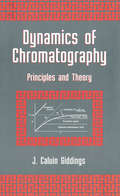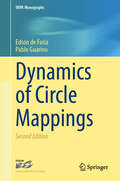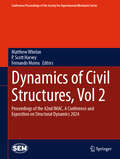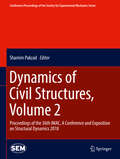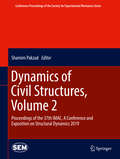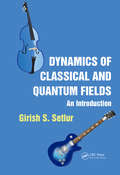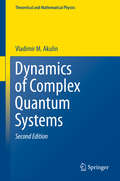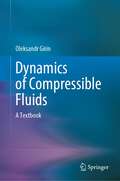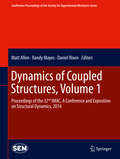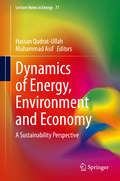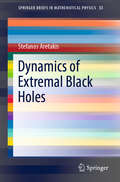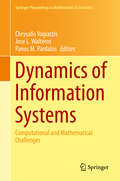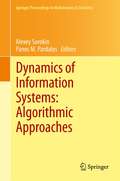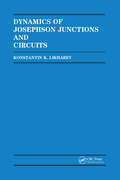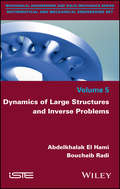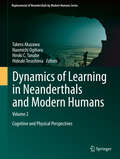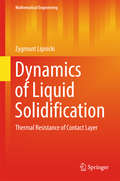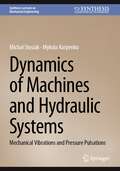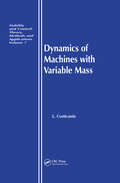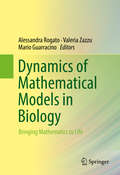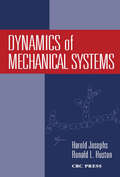- Table View
- List View
Dynamics of Chromatography: Principles and Theory
by J. Calvin GiddingsThis classic and bestselling landmark publication, originally published in 1965, examines the dynamic mechanisms, fundamental principles, and physical properties of various chromatographic procedures. It offers methods to characterize, identify, and predict chromatographic phenomena - providing strategies to select the most appropriate separation tools and techniques for specific applications in chemistry, physics, biology, and forensic and environmental science.Written by a world-renowned pioneer in the field, Dynamics of Chromatography contains many worked equations and real-world examples in gas and liquid chromatography. It includes numerous schematic figures for visualization of key concepts, introduces the means to control migration rate differences and zone spreading, and presents a detailed random-walk model for clarification of column processes. It also analyzes flow, diffusion, and kinetic events, stresses the link between theory and practice, and summarizes mathematical quantities and parameters.
Dynamics of Circle Mappings (IMPA Monographs)
by Pablo Guarino Edson de FariaThis book explores recent developments in the dynamics of invertible circle maps, a rich and captivating topic in one-dimensional dynamics. It focuses on two main classes of invertible dynamical systems on the circle: global diffeomorphisms and smooth homeomorphisms with critical points. The latter is the book's core, reflecting the authors' recent research interests.Organized into four parts and 14 chapters, the content covers rigid rotations, circle homeomorphisms, and the concept of rotation number in the first part. The second part delves into circle diffeomorphisms, presenting classical results. The third part introduces multicritical circle maps—smooth homeomorphisms of the circle with a finite number of critical points. The fourth and final part centers on renormalization theory, analyzing the fine geometric structure of orbits of multicritical circle maps. Complete proofs for several fundamental results in circle dynamics are provided throughout. The book concludes with a list of open questions.Primarily intended for graduate students and young researchers in dynamical systems, this book is also suitable for mathematicians from other fields with an interest in the subject. Prerequisites include familiarity with the content of a standard graduate course in real analysis, along with some understanding of ergodic theory and dynamical systems. Basic knowledge of complex analysis is needed for specific chapters.
Dynamics of Civil Structures, Vol. 2: Proceedings of the 42nd IMAC, A Conference and Exposition on Structural Dynamics 2024 (Conference Proceedings of the Society for Experimental Mechanics Series)
by Matthew Whelan P. Scott Harvey Fernando MoreuDynamics of Civil Structures, Volume 2: Proceedings of the 42nd IMAC, A Conference and Exposition on Structural Dynamics, 2024, the second volume of ten from the Conference brings together contributions to this important area of research and engineering. The collection presents early findings and case studies on fundamental and applied aspects of the Dynamics of Civil Structures, including papers on: Structural Vibration Dynamics of Bridges, Buildings, and Infrastructure Systems Innovative Sensors and Measurement Techniques for Structural Applications Structural Control and Vibration Mitigation Human Induced Vibrations and Human-Structure Interaction Modal Identification of Structural Systems Human Health Monitoring Using Structural Sensing Field Monitoring of Vibrations
Dynamics of Civil Structures, Volume 2: Proceedings of the 36th IMAC, A Conference and Exposition on Structural Dynamics 2018 (Conference Proceedings of the Society for Experimental Mechanics Series)
by Shamim PakzadDynamics of Civil Structures, Volume 2: Proceedings of the 36th IMAC, A Conference and Exposition on Structural Dynamics, 2018, the second volume of nine from the Conference brings together contributions to this important area of research and engineering. The collection presents early findings and case studies on fundamental and applied aspects of the Dynamics of Civil Structures, including papers on: Modal Parameter IdentificationDynamic Testing of Civil StructuresControl of Human Induced Vibrations of Civil StructuresModel UpdatingDamage Identification in Civil InfrastructureBridge DynamicsExperimental Techniques for Civil StructuresHybrid Simulation of Civil StructuresVibration Control of Civil StructuresSystem Identification of Civil Structures
Dynamics of Civil Structures, Volume 2: Proceedings of the 37th IMAC, A Conference and Exposition on Structural Dynamics 2019 (Conference Proceedings of the Society for Experimental Mechanics Series)
by Shamim PakzadDynamics of Civil Structures, Volume 2: Proceedings of the 37th IMAC, A Conference and Exposition on Structural Dynamics, 2019, the second volume of eight from the Conference brings together contributions to this important area of research and engineering. The collection presents early findings and case studies on fundamental and applied aspects of the Dynamics of Civil Structures, including papers on:Structural Vibration Humans & Structures Innovative Measurement for Structural Applications Smart Structures and Automation Modal Identification of Structural Systems Bridges and Novel Vibration Analysis Sensors and Control
Dynamics of Classical and Quantum Fields: An Introduction
by Girish S. SetlurDynamics of Classical and Quantum Fields: An Introduction focuses on dynamical fields in non-relativistic physics. Written by a physicist for physicists, the book is designed to help readers develop analytical skills related to classical and quantum fields at the non-relativistic level, and think about the concepts and theory through numerous probl
Dynamics of Complex Quantum Systems
by Vladimir M. AkulinThis book gathers together a range of similar problems that can be encountered in different fields of modern quantum physics and that have common features with regard to multilevel quantum systems. The main motivation was to examine from a uniform standpoint various models and approaches that have been developed in atomic, molecular, condensed matter, chemical, laser and nuclear physics in various contexts. The book should help senior-level undergraduate, graduate students and researchers putting particular problems in these fields into a broader scientific context and thereby taking advantage of well-established techniques used in adjacent fields. This second edition has been expanded to include substantial new material (e. g. new sections on Dynamic Localization and on Euclidean Random Matrices and new chapters on Entanglement, Open Quantum Systems, and Coherence Protection). It is based on the author's lectures at the Moscow Institute of Physics and Technology, at the CNRS Aimé Cotton Laboratory, and on other courses he has given over the last two decades.
Dynamics of Composite Materials (Advances in Dielectrics)
by Andreas Schönhals Paulina SzymoniakThe book presents recent developments in the field of composites, investigated by Broadband Dielectric Spectroscopy (BDS) and sheds a special focus on nanocomposites. This volume compares the results obtained by BDS with data from other methods like hyphenated calorimetry, dynamical-mechanical spectroscopy, NMR spectroscopy and neutron scattering. The addressed systems range from all kinds of model systems, such as polymers filled with spherical silica particles, advanced materials such as polymers with molecular stickers or hyperbranched polymer-based matrices to industrially significant systems, like epoxy-based materials. The book offers an excellent insight to a valuable application of dielectric spectroscopy and it is a helpful guide for every scientist who wants to study dynamics in composite materials.
Dynamics of Compressible Fluids: A Textbook
by Oleksandr GirinCompressibility is a property inherent in any material, but it does not always manifest itself. Experience suggests that it affects the medium motion only at velocities comparable to the speed of sound. Why do we study compressibility? It turns out that in order to calculate the aircraft streamlining or the internal flow in its engine, or the shell muzzle velocity, or the dynamic load of a shock wave from an accidental blast on a structural element, and in many other cases it is necessary to know and understand the laws of the Dynamics of Compressible Media (DCM) and be able to apply them in practice. This textbook is designed to help readers achieve this goal and learn the basics of DCM. This field of knowledge is high-tech and always focuses on the future: modern developments of hypersonic aircraft, designing more advanced structural elements for airplanes and helicopters, calculating the car aerodynamics, etc. Paradoxes have always given impetus to the search for new technological devices. Unusual effects in DCM include the flow chocking in supersonic outflow from reservoirs (Sect.2.2); the shock wave formation inside an initially smooth flow (Sect.5.3); the generation of a "spallation saucer" of armor inside a tank when a shell hits it (Sect.5.5); the dog-leg of a plane discontinuity surface at shockwave reflection from a rigid wall (Sec.8.1). The way to understand these and other effects is through the creation of quantitative models of a moving compressible fluid.
Dynamics of Coupled Structures, Volume 1
by Matt Allen Daniel Rixen Randy MayesThis first volume of eight from the IMAC-XXXII Conference, brings together contributions to this important area of research and engineering. The collection presents early findings and case studies on fundamental and applied aspects of Structural Dynamics, including papers on: Linear Systems Substructure Modelling Adaptive Structures Experimental Techniques Analytical Methods Damage Detection Damping of Materials & Members Modal Parameter Identification Modal Testing Methods System Identification Active Control Modal Parameter Estimation Processing Modal Data
Dynamics of Energy, Environment and Economy: A Sustainability Perspective (Lecture Notes in Energy #77)
by Muhammad Asif Hassan Qudrat-UllahThe book addresses the vital and interwoven areas of energy, environment, and the economy within the field of sustainability research. Fundamental technical details, empirical data, and case studies taking into account local and international perspectives are included. Issues such as energy security, depleting fossil fuel reserves, global warming and climate change, as well as novel energy technologies are covered. The dynamic global response will be discussed from the perspective of policy, technology, and economics.Vital details in the form of text boxes, illustrations, graphs, tables and appendices are included. The book will serve as reference book for upper-level undergraduate and graduate students, researchers, academics, policy makers, NGOs and developmental sector professionals within the field.
Dynamics of Extremal Black Holes (SpringerBriefs in Mathematical Physics #33)
by Stefanos AretakisThis Brief presents in a self-contained, non-technical and illustrative fashion the state-of-the-art results and techniques for the dynamics of extremal black holes. Extremal black holes are, roughly speaking, either maximally rotating or maximally charged. Astronomical observations suggest that near-extremal (stellar or supermassive) black holes are ubiquitous in the universe. The book presents various recently discovered characteristic phenomena (such as the horizon instability) that have enhanced our understanding of the dynamics of extremal black holes. The topics should be of interest to pure mathematicians, theoretical physicists and astronomers. This book provides common ground for communication between these scientific communities.
Dynamics of Galaxies
by Giuseppe BertinOur understanding of galaxies, the building blocks of the Universe has advanced significantly in recent years. New observations from ground- and space-based telescopes, the discovery of dark matter, and new insights into its distribution have been instrumental in this. This textbook provides graduate students with a modern introduction to the gravitationally-determined structure and evolution of galaxies. Readers will also benefit from detailed discussions of the issues involved in the process of modeling complex stellar systems. Additionally, the text provides an accessible framework for interpreting observations and devising new observational tests. Based on the author's extensive teaching experience, this Second Edition features an up to date view of basic phenomenology, a discussion of the structure of dark halos in galaxies, the dynamics of quasi-relaxed stellar systems and globular clusters, galaxies and gravitational lensing and an introduction to self-gravitating accretion disks. Extended problem sets are available from the accompanying resources website: www. cambridge. org/9781107000544.
Dynamics of Gas-Surface Interactions
by Ricardo Diez Muino Heriberto Fabio BusnengoThis book gives a representative survey of the state of the art of research on gas-surface interactions. It provides an overview of the current understanding of gas surface dynamics and, in particular, of the reactive and non-reactive processes of atoms and small molecules at surfaces. Leading scientists in the field, both from the theoretical and the experimental sides, write in this book about their most recent advances. Surface science grew as an interdisciplinary research area over the last decades, mostly because of new experimental technologies (ultra-high vacuum, for instance), as well as because of a novel paradigm, the 'surface science' approach. The book describes the second transformation which is now taking place pushed by the availability of powerful quantum-mechanical theoretical methods implemented numerically. In the book, experiment and theory progress hand in hand with an unprecedented degree of accuracy and control. The book presents how modern surface science targets the atomic-level understanding of physical and chemical processes at surfaces, with particular emphasis on dynamical aspects. This book is a reference in the field.
Dynamics of Information Systems
by Panos M. Pardalos Chrysafis Vogiatzis Jose L. WalterosThe contributions of this volume stem from the "Fifth International Conference on the Dynamics of Information Systems" held in Gainesville, FL in February 2013, and discuss state-of the-art techniques in handling problems and solutions in the broad field of information systems. Dynamics of Information Systems: Computational and Mathematical Challenges presents diverse aspects of modern information systems with an emphasis on interconnected network systems and related topics, such as signal and message reconstruction, network connectivity, stochastic network analysis, cyber and computer security, community and cohesive structures in complex networks. Information systems are a vital part of modern societies. They are essential to our daily actions, including social networking, business and bank transactions, as well as sensor communications. The rapid increase in these capabilities has enabled us with more powerful systems, readily available to sense, control, disperse, and analyze information.
Dynamics of Information Systems: Algorithmic Approaches
by Panos M. Pardalos Alexey SorokinDynamics of Information Systems: Algorithmic Approaches presents recent developments and results found by participants of the Fourth International Conference on the Dynamics of Information Systems, which took place at the University of Florida, Gainesville FL, USA on February 20-22, 2012. The purpose of this conference was to bring together scientists and engineers from industry, government, and universities to exchange knowledge and results in a broad range of topics relevant to the theory and practice of the dynamics of information systems. Dynamics of Information plays an increasingly critical role in our society. The influence of information on social, biological, genetic, and military systems must be better understood to achieve large advances in the capability and understanding of these systems. Applications are widespread and include: detection of terrorist networks, design of highly efficient businesses, computer networks, quantum entanglement, genome modeling, multi-robotic systems, and industrial and manufacturing safety. The book contains state-of-the-art work on theory and practice relevant to the dynamics of information systems. It covers algorithmic approaches to numerical computations with infinite and infinitesimal numbers; presents important problems arising in service-oriented systems, such as dynamic composition and analysis of modern service-oriented information systems and estimation of customer service times on a rail network from GPS data; addresses the complexity of the problems arising in stochastic and distributed systems; and discusses modulating communication for improving multi-agent learning convergence. Network issues--in particular minimum-risk maximum-clique problems, vulnerability of sensor networks, influence diffusion, community detection, and link prediction in social network analysis, as well as a comparative analysis of algorithms for transmission network expansion planning--are described in later chapters.
Dynamics of Josephson Junctions and Circuits
by Konstantin K. LikharevThis monograph offers a detailed description of the statistics, dynamics and statics of Josephson junctions. Particular emphasis is placed on the dynamics of new circuits and analog and digital devices using single quanta of magnetic flux.
Dynamics of Large Structures and Inverse Problems
by Abdelkhalak El Hami Bouchaib RadiThis book deals with the various aspects of stochastic dynamics, the resolution of large mechanical systems, and inverse problems. It integrates the most recent ideas from research and industry in the field of stochastic dynamics and optimization in structural mechanics over 11 chapters. These chapters provide an update on the various tools for dealing with uncertainties, stochastic dynamics, reliability and optimization of systems. The optimization–reliability coupling in structures dynamics is approached in order to take into account the uncertainties in the modeling and the resolution of the problems encountered. Accompanied by detailed examples of uncertainties, optimization, reliability, and model reduction, this book presents the newest design tools. It is intended for students and engineers and is a valuable support for practicing engineers and teacher-researchers.
Dynamics of Learning in Neanderthals and Modern Humans Volume 2
by Takeru Akazawa Naomichi Ogihara Hiroki C Tanabe Hideaki TerashimaThis volume is the second of two volumes of proceedings from the International Conference on the Replacement of Neanderthals by Modern Humans, which took place in Tokyo in November 2012. This second volume reports, in four major sections, findings by cultural anthropologists, physical anthropologists, engineering scientists and neurophysiologists, integrated in multidisciplinary fashion to solidify the overall understanding of the mechanics of replacement from cognitive and physical perspectives. Part 1 provides examinations of replacement related questions from various perspectives in cognition and psychology. Part 2, consisting of studies rooted in body science and genetics, provides detailed findings which fill in the broader frame of the replacement phenomenon. Part 3 presents a collection of papers whose findings about fossil crania and brain morphology shed direct light on immediate questions regarding replacement. Part 4 provides illuminations similar to those in part 3, but arising from the analytical empowerment afforded by neuroscience. The collection of 26 papers in this volume makes available to readers both broad and narrow insights on the mechanisms of the replacement/assimilation of Neanderthals by modern humans and at the same time provides a model of new-paradigm multidisciplinary collaboration on a complex problem.
Dynamics of Liquid Solidification
by Zygmunt LipnickiThis monograph comprehensively describes phenomena of heat flow during phase change as well as the dynamics of liquid solidification, i. e. the development of a solidified layer. The book provides the reader with basic knowledge for practical designs, as well as with equations which describe processes of energy transformation. The target audience primarily comprises researchers and experts in the field of heat flow, but the book may also be beneficial for both practicing engineers and graduate students.
Dynamics of Machines and Hydraulic Systems: Mechanical Vibrations and Pressure Pulsations (Synthesis Lectures on Mechanical Engineering)
by Mykola Karpenko Michał StosiakThe subject of this book is to examine the influence of mechanical vibration on the changes in the pressure pulsation spectrum of hydraulic systems. In book shows that machines and equipment equipped with hydraulic systems are a source of vibration with a wide frequency spectrum. Additionally, hydraulic valves are also exposed to vibration. Vibrations of the substrate on which the hydraulic valve is installed force the control element of the hydraulic valve to vibrate. The control element's vibration produced in this way causes changes in the pressure pulsation spectrum of the hydraulic system. A friction model modified using mixed friction theory can be used for the oscillating motion of the hydraulic directional control spool. Passive vibration isolation methods are proposed to reduce valve vibration. The biomimetic approach can be implemented in hydraulic systems (for pipelines) to reduce mechanical vibration and fluid pulsation. Numerical methods are employed to analyze the effectof changes in the pressure pulsation spectrum on the hydraulic efficiency of the pipelines. Examples are provided for the implementation of numerical methods in the calculation of hydraulic components and systems. Additionally, the effects of energy-saving in hydraulic systems by applying the proposed results overview in the current book. The current book will be interesting for both–scientific and manufacturing staff, since the implementation of knowledge can help to design more substantiable construction of machine hydraulic systems to avoid vibration problems.
Dynamics of Machines with Variable Mass
by L CveticaninDesigned to be a complete and integrated text on the dynamic properties of machines, mechanisms, and rotors with variable mass, this book presents new results from investigations based on the general dynamics of systems with variable parameters. The book considers both weak and strong nonlinear vibrations of these systems, and chaotic phenomena are also discussed. The conservation laws and adiabatic invariants for systems with variable mass are formulated and the stability and instability conditions of motion are defined.
Dynamics of Magnetically Trapped Particles
by Juan G. Roederer Hui ZhangThis book is a new edition of Roederer's classic Dynamics of Geomagnetically Trapped Radiation, updated and considerably expanded. The main objective is to describe the dynamic properties of magnetically trapped particles in planetary radiation belts and plasmas and explain the physical processes involved from the theoretical point of view. The approach is to examine in detail the orbital and adiabatic motion of individual particles in typical configurations of magnetic and electric fields in the magnetosphere and, from there, derive basic features of the particles' collective "macroscopic" behavior in general planetary environments. Emphasis is not on the "what" but on the "why" of particle phenomena in near-earth space, providing a solid and clear understanding of the principal basic physical mechanisms and dynamic processes involved. The book will also serve as an introduction to general space plasma physics, with abundant basic examples to illustrate and explain the physical origin of different types of plasma current systems and their self-organizing character via the magnetic field. The ultimate aim is to help both graduate students and interested scientists to successfully face the theoretical and experimental challenges lying ahead in space physics in view of recent and upcoming satellite missions and an expected wealth of data on radiation belts and plasmas.
Dynamics of Mathematical Models in Biology
by Valeria Zazzu Alessandra Rogato Mario GuarracinoThis volume focuses on contributions from both the mathematics and life science community surrounding the concepts of time and dynamicity of nature, two significant elements which are often overlooked in modeling process to avoid exponential computations. The book is divided into three distinct parts: dynamics of genomes and genetic variation, dynamics of motifs, and dynamics of biological networks. Chapters included in dynamics of genomes and genetic variation analyze the molecular mechanisms and evolutionary processes that shape the structure and function of genomes and those that govern genome dynamics. The dynamics of motifs portion of the volume provides an overview of current methods for motif searching in DNA, RNA and proteins, a key process to discover emergent properties of cells, tissues, and organisms. The part devoted to the dynamics of biological networks covers networks aptly discusses networks in complex biological functions and activities that interpret processes in cells. Moreover, chapters in this section examine several mathematical models and algorithms available for integration, analysis, and characterization. Once life scientists began to produce experimental data at an unprecedented pace, it become clear that mathematical models were necessary to interpret data, to structure information with the aim to unveil biological mechanisms, discover results, and make predictions. The second annual "Bringing Maths to Life" workshop held in Naples, Italy October 2015, enabled a bi-directional flow of ideas from and international group of mathematicians and biologists. The venue allowed mathematicians to introduce novel algorithms, methods, and software that may be useful to model aspects of life science, and life scientists posed new challenges for mathematicians.
Dynamics of Mechanical Systems
by Ronald Huston Harold JosephsMechanical systems are becoming increasingly sophisticated and continually require greater precision, improved reliability, and extended life. To meet the demand for advanced mechanisms and systems, present and future engineers must understand not only the fundamental mechanical components, but also the principles of vibrations, stability, and bala
